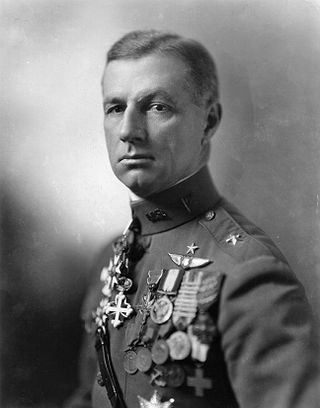
William Lendrum Mitchell was a United States Army officer who is regarded as the father of the United States Air Force.

SMS Frankfurt was a light cruiser of the Wiesbaden class built by the German Kaiserliche Marine. She had one sister ship, SMS Wiesbaden; the ships were very similar to the previous Karlsruhe-class cruisers. The ship was laid down in 1913, launched in March 1915, and completed by August 1915. Armed with eight 15 cm SK L/45 guns, Frankfurt had a top speed of 27.5 knots and displaced 6,601 t at full load.

The Helgoland class was the second class of dreadnought battleships to be built for the German Kaiserliche Marine. Constructed from 1908 to 1912, the class comprised four ships: Helgoland, the lead ship; Oldenburg; Ostfriesland; and Thüringen. The design was a significant improvement over the previous Nassau-class ships; they had a larger main battery—30.5 cm (12 in) main guns instead of the 28 cm (11 in) weapons mounted on the earlier vessels—and an improved propulsion system. The Helgolands were easily distinguished from the preceding Nassaus by the three funnels that were closely arranged, compared to the two larger funnels of the previous class. The ships retained the hexagonal main battery layout of the Nassau class.

The 20th Bomb Squadron is a unit of the 2d Operations Group of the United States Air Force located at Barksdale Air Force Base, Louisiana. The 20th is equipped with the Boeing B-52H Stratofortress.
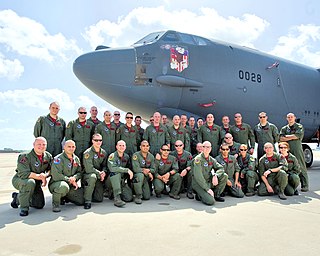
The 96th Bomb Squadron is a unit of the United States Air Force 2d Operations Group located at Barksdale Air Force Base, Louisiana. The 96th is equipped with the Boeing B-52H Stratofortress.

The Martin NBS-1 was a military aircraft of the United States Army Air Service and its successor, the Army Air Corps. An improved version of the Martin MB-1, a scout-bomber built during the final months of World War I, the NBS-1 was ordered under the designation MB-2 and is often referred to as such. The designation NBS-1, standing for "Night Bomber-Short Range", was adopted by the Air Service after the first five of the Martin bombers were delivered.

The 5th Reconnaissance Squadron is part of the 9th Reconnaissance Wing, assigned to Beale Air Force Base, California. It is stationed at Osan Air Base, South Korea as a Geographically Separated Unit (GSU). The squadron is the fifth oldest United States Air Force squadron, its history dating to 5 May 1917 as the World War I 5th Aero Squadron.

The interception of the Rex was a training exercise and military aviation achievement of the United States Army Air Corps prior to World War II. The tracking and location of an ocean-going vessel by B-17 Flying Fortresses on 12 May 1938 was a major event in the development of a doctrine that led to a United States Air Force independent of the Army. The mission was ostensibly a training exercise for coastal defense of the United States, but was conceived by planners to be a well-publicized demonstration of the capabilities of "heavy bombers (as) long range instruments of power".

The 436th Training Squadron is a non-flying training squadron of the United States Air Force. The 436th Training Squadron, located at Dyess Air Force Base, Texas, is a geographically separated unit within Air Combat Command’s 552nd Air Control Wing, at Tinker Air Force Base, Oklahoma.

The 820th Bombardment Squadron is a former Army Air Forces unit, inactivated on 4 January 1946. The squadron was first activated during World War II as the 521st Bombardment Squadron. The squadron was soon engaged in the antisubmarine campaign off the Atlantic coast of the United States as the 16th Antisubmarine Squadron.
The 25th Antisubmarine Wing is an inactive United States Air Force unit. Its last assignment was with the Army Air Forces Antisubmarine Command, based in New York City, New York. It was the principal United States Army Air Forces Unit conducting anti-submarine warfare off the East Coast of the United States and Canada until it was disbanded on 15 October 1943.
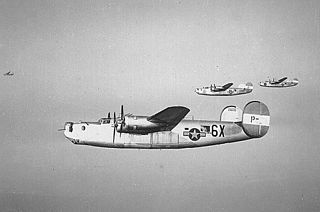
The 855th Bombardment Squadron is an inactive United States Air Force unit. The squadron was first activated as the 522d Bombardment Squadron at Lantana Airport, Florida, in October 1942, when it assumed the personnel and equipment of a National Guard unit engaged in antisubmarine warfare over the Atlantic. The squadron continued antisubmarine patrols as the 17th Antisubmarine Squadron until the summer of 1943, when its mission was transferred to the Navy.

The 859th Special Operations Squadron is a reserve unit of the United States Air Force. It was first activated in October 1942 as the 517th Bombardment Squadron, when the Army Air Forces replaced National Guard observation units that had been mobilized and were performing antisubmarine patrols off the Atlantic coastline. A month after its activation, the squadron was redesignated the 12th Antisubmarine Squadron. In August 1943, the Army Air forces began turning the antisubmarine patrol mission over to the Navy and the squadron moved to California, where, as the 859th Bombardment Squadron, it formed the cadre for the 492d Bombardment Group.

The Second Bombardment Wing, abbreviated as 2nd Bombardment Wing of the United States Army Air Forces is a disbanded unit whose last assignment was with the Continental Air Forces, based at McChord Field, Washington. It was last active in November 1945.

The 2d Operations Group is the flying component of the United States Air Force 2d Bomb Wing, assigned to the Air Force Global Strike Command Eighth Air Force. The group is stationed at Barksdale Air Force Base, Louisiana.

St. Clair Streett, known as "Bill", was a United States Air Force (USAF) major general and writer who first organized and led the Strategic Air Command (SAC). Streett served as aide to air power advocate General Billy Mitchell, and was viewed by General of the Air Force Henry H. Arnold as his own personal "troubleshooter".
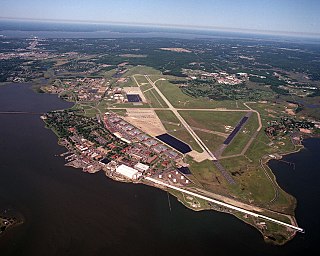
Langley Air Force Base is a United States Air Force base located in Hampton, Virginia, adjacent to Newport News. It was one of thirty-two Air Service training camps established after the entry of the United States into World War I in April 1917.

The 50th Attack Squadron is a squadron of the United States Air Force, stationed at Shaw Air Force Base, South Carolina, where it operates the General Atomics MQ-9 Reaper unmanned aerial vehicle. It is assigned to the 25th Attack Group, also at Shaw, and is a component of the 432d Wing, located at Creech Air Force Base, Nevada.
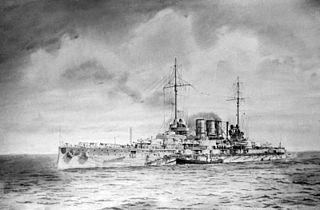
SMS Ostfriesland was the second vessel of the Helgoland class of dreadnought battleships of the Imperial German Navy. Named for the region of East Frisia, Ostfriesland's keel was laid in October 1908 at the Kaiserliche Werft dockyard in Wilhelmshaven. She was launched on 30 September 1909 and was commissioned into the fleet on 1 August 1911. The ship was equipped with twelve 30.5 cm (12 in) guns in six twin turrets, and had a top speed of 21.2 knots. Ostfriesland was assigned to the I Battle Squadron of the High Seas Fleet for the majority of her career, including World War I.

The Army Air Forces Antisubmarine Command was formed in the fall of 1942 to establish a single command to control antisubmarine warfare (ASW) activities of the Army Air Forces (AAF). It was formed from the resources of I Bomber Command, which had been carrying out the antisubmarine mission in the Atlantic and Caribbean since the Attack on Pearl Harbor due to the lack of long range Naval aviation in that area.



















